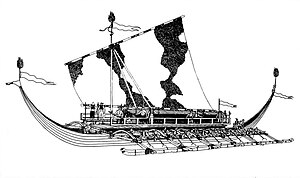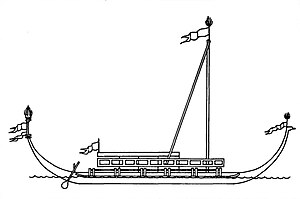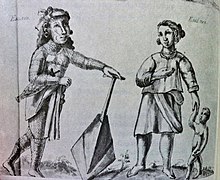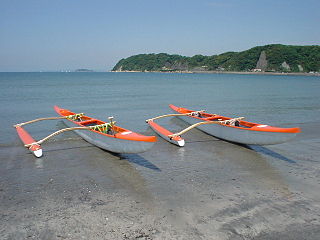
Outrigger boats are various watercraft featuring one or more lateral support floats known as outriggers, which are fastened to one or both sides of the main hull. They can range from small dugout canoes to large plank-built vessels. Outrigger boats can also vary in their configuration, from the ancestral double-hull configuration (catamarans), to single-outrigger vessels prevalent in the Pacific Islands and Madagascar, to the double-outrigger vessels (trimarans) prevalent in Island Southeast Asia. They are traditionally fitted with Austronesian sails, like the crab claw sails and tanja sails, but in modern times are often fitted with petrol engines.

The vinta is a traditional outrigger boat from the Philippine island of Mindanao. The boats are made by Sama-Bajau, Tausug and Yakan peoples living in the Sulu Archipelago, Zamboanga peninsula, and southern Mindanao. Vinta are characterized by their colorful rectangular lug sails (bukay) and bifurcated prows and sterns, which resemble the gaping mouth of a crocodile. Vinta are used as fishing vessels, cargo ships, and houseboats. Smaller undecorated versions of the vinta used for fishing are known as tondaan.

Basnig or balasnig are lift nets (salambaw) operated by a large outrigger boat called Basnigan. They use a large bag net suspended directly below or beside the ship. This net is attached to multiple temporary booms projecting from the ship's outriggers and detachable auxiliary masts. Modern basnig typically use generators and electric lights to attract fish and squid. This method is unique to the Philippines. It is common in the Visayas, particularly in the provinces of Capiz and Iloilo.

A kora-kora or kora kora or coracora is a traditional canoe from the Maluku (Moluccas) Islands, Indonesia. They are naval boat for carrying men on raids for plunder or for slaves. In Maritime Southeast Asia, raiding for slaves was an honourable way of making a living, and the kora kora was needed for defence against raids as well as for forays. Large kora-kora is called juanga or joanga.

Paraw are various double outrigger sail boats in the Philippines. It is a general term and thus can refer to a range of ship types, from small fishing canoes to large merchant lashed-lug plank boats with two outriggers (katig) propelled by sails
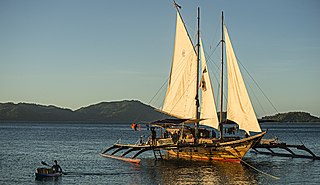
A Balangay, or barangay is a type of lashed-lug boat built by joining planks edge-to-edge using pins, dowels, and fiber lashings. They are found throughout the Philippines and were used largely as trading ships up until the colonial era. The oldest known balangay are the Butuan boats, which have been carbon-dated to 320 AD and were recovered from several sites in Butuan, Agusan del Norte.
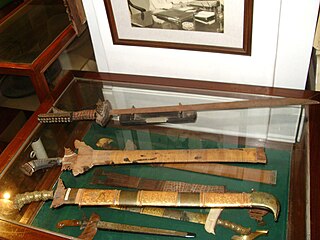
Warfare in pre-colonial Philippines refers to the military history of the Philippines prior to Spanish colonization.
Joanga or juanga is Spanish for "junk". It can also refer to other large native ships in Southeast Asia, including:

Lanong were large outrigger warships used by the Iranun and the Banguingui people of the Philippines. They could reach up to 30 m (98 ft) in length and had two biped shear masts which doubled as boarding ladders. They also had one to three banks of oars rowed by galley slaves. They were specialized for naval battles. They were prominently used for piracy and slave raids from the mid-18th century to the early 19th century in most of Southeast Asia. The name lanong is derived from Lanun, an exonym of the Iranun people.

Garay were traditional native warships of the Banguingui people in the Philippines. In the 18th and 19th centuries, they were commonly used for piracy by the Banguingui and Iranun people against unarmed trading ships and raids on coastal settlements in the regions surrounding the Sulu Sea.
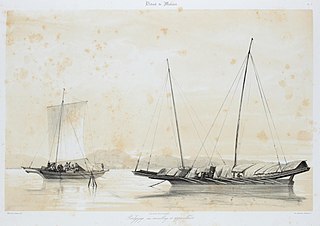
Penjajap, also pangajava and pangayaw, were native outrigger warships used by several Austronesian ethnic groups in maritime Southeast Asia. They were typically very long and narrow, and were very fast. They are mentioned as being used by native fleets in Indonesia, the southern Philippines, Malaysia, and Brunei.
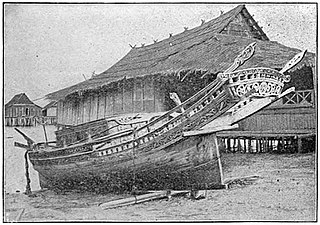
Lepa, also known as lipa or lepa-lepa, are indigenous ships of the Sama-Bajau people in the Philippines and Malaysia. They were traditionally used as houseboats by the seagoing Sama Dilaut. Since most Sama have abandoned exclusive sea-living, modern lepa are instead used as fishing boats and cargo vessels.

Bangka are various native watercraft of the Philippines. It originally referred to small double-outrigger dugout canoes used in rivers and shallow coastal waters, but since the 18th century, it has expanded to include larger lashed-lug ships, with or without outriggers. Though the term used is the same throughout the Philippines, "bangka" can refer to a very diverse range of boats specific to different regions. Bangka was also spelled as banca, panca, or panga in Spanish. It is also known archaically as sakayan.

Cascos are flat-bottomed square-ended barges from the Philippines. They were used mostly to carry cargo along lakes and rivers, and as lighters to transport goods to and from moored ships. Though they resemble the Chinese sampan, they are much larger with two detachable masts with junk rigs made of woven fiber. They also possess outrigger-like platforms along the entire length of the sides, which is used by punters with barge poles when traversing shallow water. They were steered by an oar or a central rudder by a helmsman housed in a small raised platform at the stern. The entire deck is covered almost entirely in removable curving or pitched panels.

Orembai or Arombai is a type of plank boat from the Maluku Islands of Eastern Indonesia. It is mainly used for fishing and transport. This vessel is used as far as Batavia, where in the 17th century it became popular to go out "orembaaien" on an evening rowing on the river or city canals.
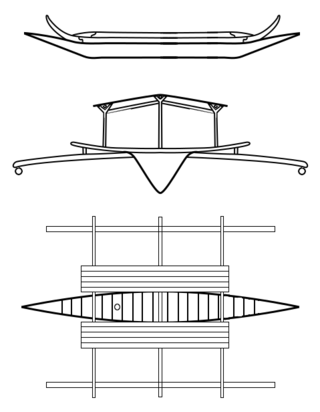
Djenging is a type of large double-outrigger plank boat built by the Sama-Bajau people of the Philippines. It is typically used as a houseboat, though it can be converted to a sailing ship. It was the original type of houseboat used by the Sama-Bajau before it was largely replaced by the lepa after World War II. Larger versions of djenging were also known as balutu or kubu, often elaborately carved with bifurcated extensions on the prow and stern.

Bangkong is the war boat of dayak people, notably used by sea dayaks of Indonesia, Malaysia and Brunei. They are used for riverine warfare in Borneo, but they are also capable of sailing across the sea.

A juanga or joanga refers to large-sized kora-kora, karakoa and lanong. They are used all throughout the Philippines and Eastern Indonesia, in Maluku smaller versions were popular and are still used to this day (Kora-kora). They are propelled by oars but are not used for carrying cargo.

Burulan is a Visayan term referring to fighting platforms on the traditional large trimaran warships (balangay) of the Philippines. They were made from bamboo and were distinctively raised from the deck. They carried the warrior-nobility of the Visayans and other passengers during travel, naval warfare, and seasonal coastal raids (mangayaw), so as to avoid interfering with the paddlers. This platform can be covered by an awning of woven palm leaves during hot days or when it rains, protecting the crew and cargo.

Daramba is a Visayan term referring to paddling and fighting platforms mounted directly on the outriggers (katig) of traditional large trimaran warships (balangay) of the Philippines. They accommodated one or more rows on each side of commoner warriors (horo-han) with large leaf-shaped paddles (bugsay) during travel, naval warfare, and seasonal coastal raids (mangayaw). The paddlers were kept in rhythm by various chants and songs. The platforms for the horo-han are distinguished from the side-mounted fighting platforms (pagguray) of the warrior-nobility, which were also built on the outriggers, in that the daramba was mounted on or near the water surface, while the pagguray was mounted above, closer to the hull.
